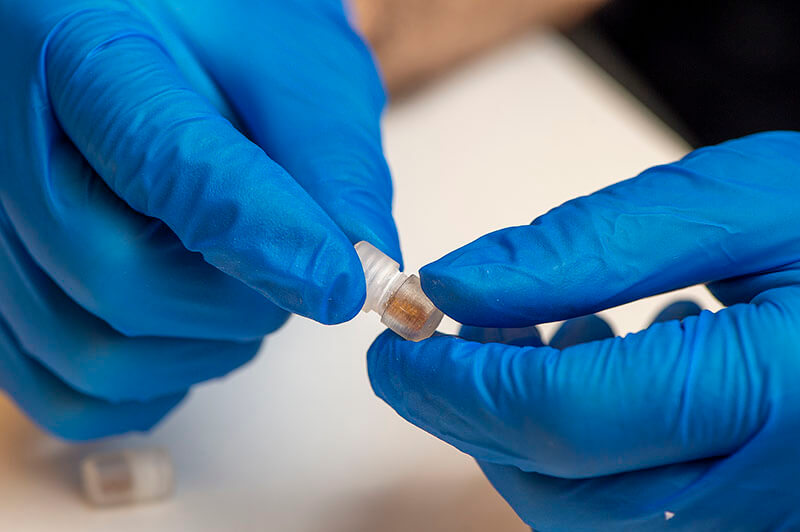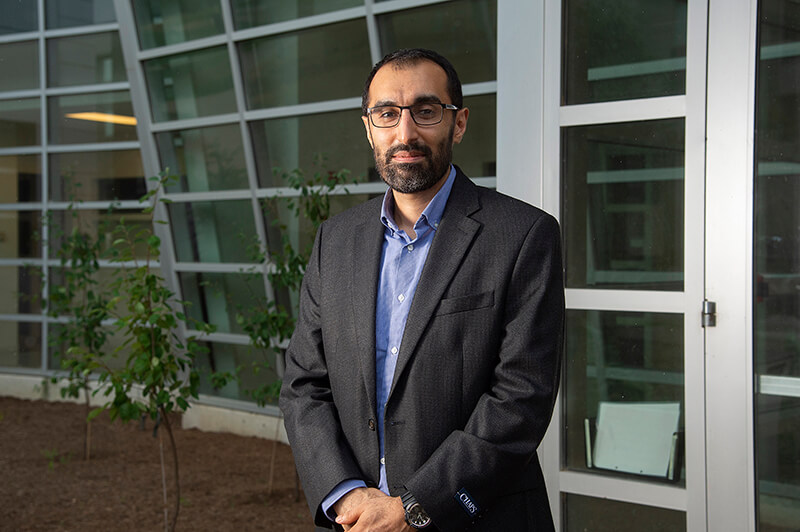August 12, 2020
Swallowing this colonoscopy-like bacteria grabber could reveal secrets about your health
WEST LAFAYETTE, Ind. — Your gut bacteria could say a lot about you, such as why you’re diabetic or how you respond to certain drugs.
But scientists can see only so much of the gastrointestinal tract to study the role of gut bacteria in your health. What comes out of you is just a small sample of these bacteria, without indicating where they came from in the digestive system.
Purdue University researchers built a way to swallow a tool that acts like a colonoscopy, except that instead of looking at the colon with a camera, the technology takes samples of bacteria.
The technology could also move throughout the whole GI tract, not just the colon. This tract, in addition to the colon, includes the mouth, esophagus, stomach, pancreas, liver, gallbladder, small intestine and rectum.
Essentially, this tool would make it possible to conduct a “gut-oscopy.” A video showing how it would work is on YouTube
 Once swallowed, this capsule is designed to collect bacteria throughout the gut. A scientist unscrews the cap to retrieve the sample after the capsule has left the digestive system. (Purdue University photo/Mark Simons)
Download image
Once swallowed, this capsule is designed to collect bacteria throughout the gut. A scientist unscrews the cap to retrieve the sample after the capsule has left the digestive system. (Purdue University photo/Mark Simons)
Download image
“It’s all about being able to take samples of bacteria anywhere in the gut. That was impossible before,” said Rahim Rahimi, a Purdue assistant professor of materials engineering.
The tool is a drug-like capsule that passively weasels through the gut without needing a battery. A pill version of a colonoscopy is already commercially available to view areas of the colon that a traditional colonoscopy can’t see, but neither tool can sample bacteria.
“If a colonoscopy or camera pill sees blood, it can’t sample that area to investigate further. You could just sample bacteria from a person’s fecal matter, but bacteria can vary a lot throughout the GI tract. Our approach could be complementary,” Rahimi said.
The bacteria-sampling capsule also would be a lot cheaper, each costing only about a dollar, he estimates.
Rahimi’s team is working on testing this capsule in pigs, which have a similar GI tract to humans. An initial demonstration of the prototype is published in RSC Advances, a journal by the Royal Society of Chemistry.
 Rahim Rahimi’s lab develops innovative materials and biomedical devices to address health care challenges. (Purdue University photo/Mark Simons)
Download image
Rahim Rahimi’s lab develops innovative materials and biomedical devices to address health care challenges. (Purdue University photo/Mark Simons)
Download image
The researchers 3D-printed the capsule out of resin, the same material used in dental molds and implants. This material would need to be slightly modified for humans to ingest, but is otherwise nontoxic, Rahimi said.
When exposed to the pH of a certain gut location, the capsule’s biodegradable cap dissolves. Inside the capsule, a hydrogel similar to those used in diapers expands and collects intestinal fluid containing bacteria. Pressure closes shut the capsule’s aperture when the sampling is complete, kind of like a plunger.
The researchers have tested the prototype capsule in a culture solution designed to simulate the gut bacterial flora of a GI tract. They also tested the capsule’s ability to protect the sampled bacteria in different extreme environments. Their experiments so far show that the capsule could successfully sample bacteria common in the gut, such as E. coli, within an hour.
In a human, the capsule would continue to move throughout the GI tract with other fecal matter. A scientist could then recover the capsule from a study participant’s fecal matter, unscrew the capsule, and study the collected bacteria.
“This approach is providing new opportunities to study what type of bacteria are present in the gut. It would help us figure out how to manipulate these bacteria to combat disease,” Rahimi said.
A patent has been filed for this technology through the Purdue Research Foundation Office of Technology Commercialization. The work is funded by Eli Lilly and Company and Purdue’s School of Materials Engineering. Rahimi’s team is conducting this research at the Birck Nanotechnology Center in Purdue's Discovery Park.
About Discovery Park
Discovery Park is a place where Purdue researchers move beyond traditional boundaries, collaborating across disciplines and with policymakers and business leaders to create solutions for a better world. Grand challenges of global health, global conflict and security, and those that lie at the nexus of sustainable energy, world food supply, water and the environment are the focus of researchers in Discovery Park. The translation of discovery to impact is integrated into the fabric of Discovery Park through entrepreneurship programs and partnerships.
About Purdue University
Purdue University is a top public research institution developing practical solutions to today’s toughest challenges. Ranked the No. 6 Most Innovative University in the United States by U.S. News & World Report, Purdue delivers world-changing research and out-of-this-world discovery. Committed to hands-on and online, real-world learning, Purdue offers a transformative education to all. Committed to affordability and accessibility, Purdue has frozen tuition and most fees at 2012-13 levels, enabling more students than ever to graduate debt-free. See how Purdue never stops in the persistent pursuit of the next giant leap at https://purdue.edu/.
Media Contact: Amy Patterson Neubert, 765-412-0864, apatterson@purdue.edu
Writer: Kayla Wiles, wiles5@purdue.edu
Source: Rahim Rahimi, rrahimi@purdue.edu
Journalists visiting campus: Journalists should follow Protect Purdue protocols and the following guidelines:
- Campus is open, but the number of people in spaces may be limited. We will be as accommodating as possible, but you may be asked to step out or report from another location.
- To enable access, particularly to campus buildings, we recommend you contact the Purdue News Service media contact listed on the release to let them know the nature of the visit and where you will be visiting. A News Service representative can facilitate safe access and may escort you on campus.
- Wear face masks inside any campus building. Wear face masks outdoors when social distancing of at least six feet is not possible.
ABSTRACT
Smart capsule for non-invasive sampling and studying of the gastrointestinal microbiome
Jose Fernando Waimin,ab Sina Nejati,ab Hongjie Jiang,bcd Jake Qiu,be
Jianghsan Wang,be Mohit S. Vermabef and Rahim Rahimiabc
aSchool of Materials Engineering, Purdue University, West Lafayette, Indiana, 47907,
USA.
bBirck Nanotechnology Center, Purdue University, West Lafayette, IN 47907, USA
cSchool of Electrical Engineering, Purdue University, West Lafayette, Indiana, 47907,
USA
dShenzhen MSU-BIT University, Shenzhen, Guangdong, China
eDepartment of Agricultural and Biological Engineering, Purdue University, West
Lafayette, IN 47907, USA
fWeldon School of Biomedical, Purdue University, West Lafayette, IN 47907, USA
DOI: 10.1039/c9ra10986b
Gut microbiota plays an important role in host physiology such as obesity, diabetes, and various neurological diseases. Thus, microbiome sampling is a fundamental approach towards better understanding of possible diseases. However, conventional sampling methods, such as endoscopies or colonoscopies, are invasive and cannot reach the entire small intestine. To address this need, a battery-less 3D-printed sampling capsule, which can collect microbiome samples throughout the entirety of the GI tract was designed. The capsule (9 mm × 15 mm) consists of a 3D printed acrylic housing, a fast-absorbing hydrogel, and a flexible PDMS membrane. Fluids containing samples of the microbial flora within the GI tract enter the device through a sampling aperture on the cap of the device. Once the microbiome enters the housing, the hydrogel absorbs the fluid and swells, effectively protecting the samples within its polymeric matrix, while also pushing on the flexible PDMS membrane to block the sampling aperture from further fluid exchange. The retrieved capsule can be readily disassembled due to the screw-cap design of the capsule and the hydrogel can be removed for further bacterial culture and analysis. As a proof of concept, the capsule's bacterial sampling efficiency and the ability to host microbial samples within the hydrogel in a sealed capsule were validated using a liquid culture containing Escherichia coli. The demonstrated technology provides a promising inexpensive tool for direct sampling and assessment of microbes throughout the GI tract and can enable new insights into the role of diet in mediating host–microbe interactions and metabolism.
Note to journalists: For a copy of the paper, please contact Amy Patterson Neubert, Purdue News Service, at apatterson@purdue.edu. A video explaining how the bacteria-grabbing capsule works is on YouTube. Photos and b-roll of researchers working with the capsule are available in a Google Drive folder. Journalists visiting campus should follow visitor health guidelines.

